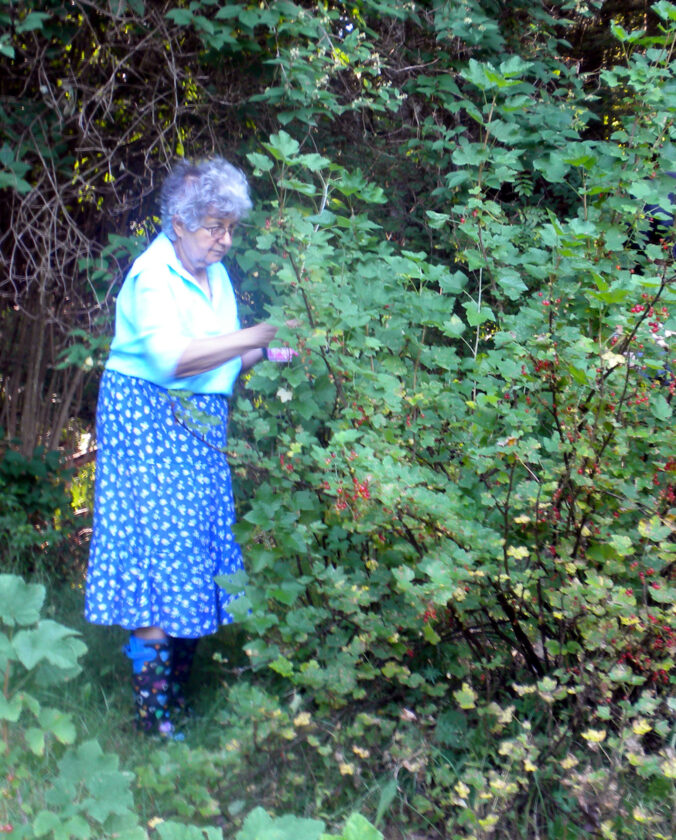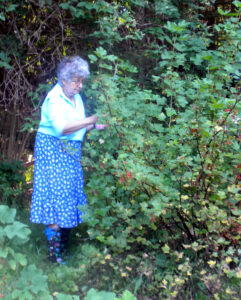Another little-known berry

Mom with a currant bush in 2012 (Provided photo — Yvona Fast)
Another little-known berry is the currant. The ribes family includes several varieties, including ribes negrum (blackcurrant) and ribes rubrum (red currant). Berries come in black, red and white and grow on deciduous bushes that are 3 to 5 feet tall. The ornamental bushes are great for home gardeners and small farmers.
Currants grow well in our northern climate and are well-adapted to USDA Hardiness Zones 3 through 5 in the North Country. They grow best in temperatures below 85 degrees Fahrenheit, need winter frosts, and are damaged by intense sunlight or drought conditions. They grow quickly and need little space to provide a bountiful harvest. Mom planted several redcurrant and blackcurrant bushes, and the birds have spread them, so now I have many more.
Greg Quinn, a Hudson Valley horticulturalist with marketing and culinary skills, calls the black currant “the miraculous little berry that nobody knows about.” He was looking for a niche crop, a fruit or vegetable the region was lacking, when he was introduced to a black currant liqueur at a local winery. Captivated by the berry’s health benefits, he believes that the small fruit could revitalize New York agriculture.
These berries grow wild in northern Europe, Asia and North America. Cultivation of the puckering, astringent fruit began in the 16th century in Denmark and Holland, and a little later in France. Today, they’re popular throughout central and eastern Europe. The American variety of redcurrants (ribes triste) has been used by native people for food and medicine for thousands of years.
It was also in the 16th century that currants’ medicinal properties became known. English and German herbals list redcurrant berries as having fever-reducing, sweat-inducing, mildly laxative, diuretic and digestive properties. European herbals use blackcurrants as a cure for colds and throat ailments; to treat kidney and bladder problems, skin rashes, liver disorders, colds and coughs. The leaves are brewed for tea to relieve rheumatism and gout, as a rinse or gargle for mouth and throat infections, and applied to wounds to promote healing.
Modern science has confirmed the benefits of these small berries. Currants have twice the antioxidants of blueberries, quadruple the vitamin C of oranges, and double the potassium of bananas. With summer in full swing and the vibrant red and purple berries appearing at farmers’ markets, it is time to get to know these ruby red gems a little better.
A Scottish study established that blackcurrants are richer in antioxidants and vitamin C than any other fruit, including blueberries and pomegranates. In addition, they’re a good source of vitamins riboflavin and A, as well as many minerals: potassium, calcium, magnesium, manganese and phosphorus.
Like other dark-colored fruits and berries, currants’ purple, blue and red pigments contain many antioxidants, anthocyanins and phytonutrients with anti-inflammatory, antimicrobial and cancer-fighting properties. They help prevent cancer, heart disease, Alzheimer’s (2006 Tufts University Study), diabetes and high blood pressure. Blackcurrant seed oil is a rich source of gamma-linolenic acid, a rare but essential fatty acid. While redcurrants have somewhat less of these antioxidants, phytonutrients and vitamins, they are still quite good for you.
The berries are popular in Eastern and central Europe, where they’re used to make jellies, jams, syrups, liqueur and candy. From France to Scandinavia, currants are made into juice and wine, used in summer desserts, drinks, granitas and sorbets, and added to cordials, liqueurs, yogurt and ice cream. They’re a popular ingredient in Scandinavian fruit soups, English summer puddings and German custard tarts.
They’re often cooked and incorporated into dishes where their bright astringent flavor complements sweet and savory foods, from sauces and meat dishes to a myriad of desserts. On the savory side, they’re great stirred into gravies and sauces or matched with roasts. They can be tossed into salads of mixed greens as well as grain, potato and pasta salads. On the sweet side, they’re great in baked goods like pies, cobblers, crisps, muffins, sweetbreads and scones. High in pectin, they are often made into jams and jellies. They also make great ice creams, sorbets and summer bread pudding.
–
Blackcurrant and Blueberry Smoothie
–
Ingredients:
2/3 cup black currants
2/3 cup blueberries
1 small ripe banana
1 1/3 cup apple juice or water
Directions:
Place all ingredients in blender and mix.
Note: If using water, you may want to sweeten to taste with local honey or maple syrup.
Serves 2.
–
Fresh Greens Salad with Red Currants
–
Ingredients:
1 small clove garlic
1/2 teaspoon salt
2 tablespoons walnut oil or olive oil
2 tablespoons balsamic vinegar
1 pound fresh salad greens (lettuces, arugula, mizuna, mesclun, etc.)
1 small sweet onion, peeled and sliced thin
1 cup red currants (about 1/4 pound)
1 apple, cored and sliced into bite-size pieces
1/2 cup walnuts, toasted OR
Lightly seasoned cooked chicken cut into bite-size pieces (optional)
Directions:
Crush garlic with salt (I use a mortar and pestle for this). Add oil and vinegar, and whisk with a fork.
Wash greens. Shred and add to the dressing, and toss. Add remaining ingredients. Toss again. Serve right away. Serves 3 – 4.
–
Currant Sauce
–
This sauce, common in Eastern Europe, is equally good with pancakes, pound cake, fish, poultry, or meat (as you would cranberry sauce).
Ingredients:
1 cup currants (red, black, or combination)
1/2 cup apple juice or cider
1/3 cup maple syrup (more if you like it sweeter)
1/2 cup water
2 tablespoons cornstarch
Directions:
Use a blender or food processor to puree the blackcurrants. Pour the puree through a sieve to remove seeds and pips and leave a smooth mixture.
Bring currants, syrup, and cider to a boil. Whisk together cornstarch and water; whisk into hot liquid and return to boil. Cook 1-2 minutes, remove from heat, and cool. Chill. Sauce should gel.
For a richer and prettier dessert option, stir together 1 tablespoon maple syrup and 1/3 cup sour cream. Fold into sauce to make white swirls. Serve in bowls as you would pudding, or on top of cheese cake or tartlets.
——
Author of the award-winning cookbook Garden Gourmet: Fresh & Fabulous Meals from your Garden, CSA or Farmers’ Market, Yvona Fast lives in Lake Clear and has two passions: writing and cooking. She can be found at www.yvonafast.com and reached at yvonawrite @yvonawrites.




